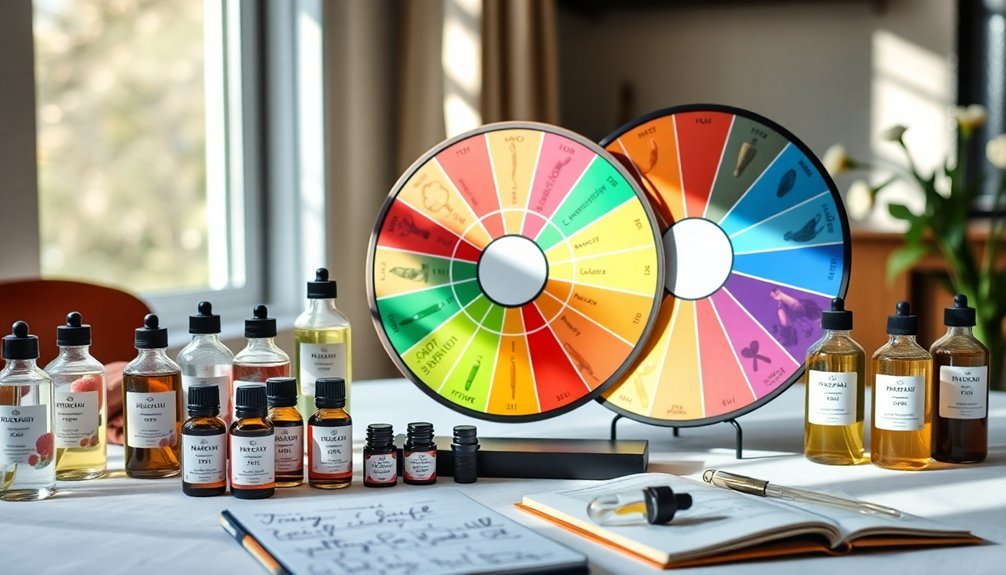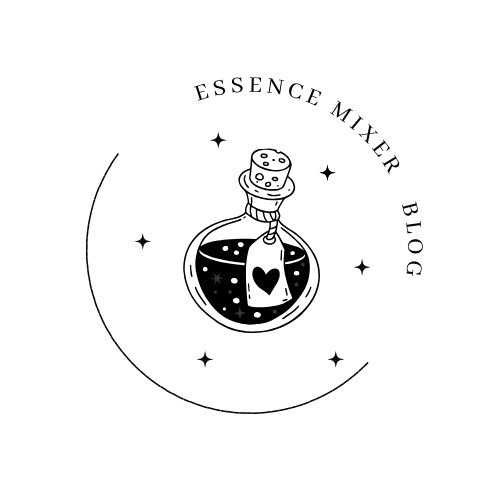Master DIY perfume making by understanding the four main scent families: Floral, Amber, Woody, and Fresh. You'll create balanced fragrances using the 30-50-20 rule for top, middle, and base notes. Start with a dominant note from your preferred family, then add complementary scents from the fragrance wheel. Keep detailed records of your blends and test combinations in small batches. Discover how mastering these fundamental principles will transform your perfume-making journey.
Understanding the Basics of Scent Families

When delving into the world of DIY perfumes, you'll first need to grasp the four main scent families: Floral, Amber, Woody, and Fresh.
The fragrance wheel organizes these families to help you understand how different aromas complement each other and create complex compositions.
If you're drawn to romantic and feminine notes, explore floral scents like jasmine and rose.
For warmer, more sensual creations, try Amber's rich vanilla and spice combinations.
Woody notes offer earthy depth through sandalwood and cedar, often pairing beautifully with florals for added dimension.
Fresh fragrances deliver invigorating citrus and aquatic elements, perfect for clean, masculine blends.
Each scent family branches into subfamilies, giving you endless possibilities to craft unique perfumes that match your preferences and creative vision.
Essential Components of the Fragrance Wheel
You'll find the fragrance wheel divided into four main families – Floral, Amber, Woody, and Fresh – which serve as your foundation for creating custom perfumes.
These families break down into more specific subfamilies, letting you pinpoint exact scent characteristics and understand how different notes work together, from top notes that hit immediately to base notes that linger.
When you're blending fragrances, you can use the wheel's layout to pair neighboring families, creating harmonious combinations that complement each other naturally.
Main Scent Family Categories
Understanding the fragrance wheel's four main scent families is essential for creating your own perfumes. You'll discover that each family carries distinct fragrance notes that'll help you craft unique combinations. When working with floral and fresh scents, you'll capture everything from delicate flower essences to invigorating citrus notes. Woody fragrances bring earthiness to your creations, while amber scents add warmth and depth.
| Scent Family | Key Characteristics |
|---|---|
| Floral | Jasmine, rose, bouquet notes |
| Amber | Vanilla, cinnamon, spicy-sweet |
| Woody | Cedarwood, sandalwood, earthy |
| Fresh | Citrus, herbal, aquatic notes |
These families serve as your foundation for blending perfumes. By understanding their characteristics, you'll be able to create balanced compositions that reflect your desired olfactory experience.
Fragrance Note Classification
The fragrance wheel divides perfume components into three distinct layers: top, middle, and base notes.
When you're creating your DIY perfume, you'll notice top notes hit your senses first with bright, fresh scents like citrus and herbs, but they quickly fade away.
As your fragrance develops, the middle notes emerge as the heart of your creation. These notes, which often include floral and fruity fragrance families, create the perfume's core character and bridge the gap between initial and final impressions.
Your base notes are the foundation that'll stick around the longest. They're rich, deep scents like woods, resins, and musks that anchor your perfume.
Understanding these three layers helps you blend ingredients strategically, ensuring your DIY perfume maintains a balanced scent profile throughout its wear time.
Aroma Blending Principles
Building on your knowledge of fragrance notes, mastering the fragrance wheel opens up endless possibilities for creating unique scent combinations.
You'll find that successful aroma blending relies on understanding how different scent families interact with each other.
When you're working on perfume creation, start by exploring kindred notes within the same family for harmonious blends. For more complex fragrances, try pairing complementary notes from opposite sides of the fragrance wheel.
You'll want to evaluate how your top note will interact with middle and base notes over time. For example, you might combine a fresh citrus top note with woody base notes for depth and longevity.
Remember that the wheel's four main families – Floral, Amber, Woody, and Fresh – serve as your roadmap to creating balanced, sophisticated fragrances that evolve beautifully on the skin.
Mastering Fragrance Note Combinations
When creating your own signature scent, mastering fragrance note combinations becomes an essential skill that transforms basic mixing into an art form.
The scent wheel serves as your guide, helping you understand how different fragrance families interact and complement each other.
You'll discover that opposite notes on the aroma wheel often create intriguing combinations, like pairing fresh citrus with rich amber notes.
Start experimenting with complementary families, such as blending floral with woody notes, or spicy amber with deep woods.
As you work with DIY perfumes, remember to layer your notes strategically – combining top, middle, and base notes for a well-rounded fragrance.
Don't be afraid to explore subfamilies within each category; a fresh citrus note can beautifully harmonize with soft florals to create your perfect signature blend.
Creating Your Signature Scent Blend

Start your signature scent journey by selecting base notes that align with your preferred fragrance family on the wheel, whether it's the warmth of amber or the earthiness of wood.
You'll want to balance these foundational elements with complementary scent families, such as pairing floral with fresh notes or woody with oriental accords.
Test your combinations in small batches, keeping detailed notes of each blend's performance and how the fragrances interact with your skin chemistry over time.
Finding Your Base Notes
To establish a memorable and enduring fragrance, understanding base notes is crucial since they form the foundation of your signature scent.
When crafting your luxurious fragrance, you'll want to incorporate 20-30% base notes to create depth and staying power. From creamy sandalwood to rich amber, these earthy notes will anchor your perfume and help it evolve beautifully on your skin.
Follow these key steps when selecting base notes on the perfume wheel:
- Start with classic foundations like patchouli, musk, or vanilla to guarantee longevity.
- Combine complementary base notes that harmonize with your chosen top and middle notes.
- Test different combinations on your skin, as base notes can develop uniquely based on your body chemistry.
Balancing Fragrance Families Together
Creating a signature scent blend requires mastering the delicate art of combining fragrance families. Start by identifying your preferred family on the fragrance wheel, whether it's Floral, Woody, or another category that resonates with you. This choice will form the foundation of your unique scent.
To achieve a balanced olfactory experience, pair complementary notes from opposite families on the wheel. For instance, you'll create dynamic contrasts by combining Fresh citrus with warm Amber notes.
Work with subfamilies to add depth – try blending Soft Floral elements with Woody undertones. Remember to maintain the 3:2:1 ratio of base, middle, and top notes to guarantee no single scent overpowers the others.
Monitor how your blend evolves and adjust accordingly, as certain notes may become more prominent over time.
Testing Scent Combinations
When developing your signature scent blend, methodical testing becomes essential for achieving the perfect combination. Start by selecting your base scent from the fragrance wheel, then explore complementary scents that create harmony with your foundation note.
- Test your scent combinations on blotter strips first, allowing you to evaluate how different notes interact without the influence of body chemistry.
- Document each blend in your fragrance journal, noting which pairings work well together and which create discord.
- Apply promising combinations to your skin, as your natural chemistry can transform how fragrances evolve throughout the day.
Remember to explore contrasting families on the wheel, like fresh citrus with warm amber, to create depth in your blend.
Take your time with this process, as finding the perfect balance requires patience and experimentation.
Expert Tips for DIY Perfume Making

Mastering the art of DIY perfume making starts with understanding the fundamental principles of fragrance composition. Use the fragrance wheel as your guide to navigate through the main scent family includes Floral, Amber, Woody, and Fresh categories.
When selecting your notes, remember that fragrance families work best when paired thoughtfully.
Tips When Using the wheel: Start by identifying your preferred scent family, then build your composition with complementary notes. Combine fresh top notes with harmonious middle notes, and anchor them with lasting base notes.
Keep track of your combinations in a detailed journal – you'll thank yourself later when recreating successful blends. For best results, experiment with kindred notes within related fragrance families, such as pairing woody base notes with amber accents for a sophisticated, long-lasting scent.
Troubleshooting Common Blending Challenges
While understanding fragrance theory builds a strong foundation, even experienced perfumers face common blending challenges.
In the perfume industry, successful scent creation requires both technical knowledge and practical problem-solving skills. When you're blending fragrances, keeping track of your experiments in a fragrance journal helps identify what works and what doesn't.
- If your blend seems unbalanced, adjust your ratios using the 30-50-20 rule (top, middle, and base notes) for strategic scent placement.
- When working with different fragrance families, start with your dominant note and gradually add complementary scents from the fragrance wheel.
- For harsh or overwhelming blends, introduce softer middle notes or dilute with base notes until you achieve the desired harmony.
Frequently Asked Questions
What Does the Fragrance Wheel Method Do?
The Fragrance Wheel method helps you categorize and understand perfume scents through four main families: Floral, Amber, Woody, and Fresh. It'll guide you in selecting and combining complementary fragrances for balanced scent creation.
Where Does Vanilla Sit on the Fragrance Wheel?
You'll find vanilla in the Amber family (formerly Oriental) on the fragrance wheel. It's a warm, sweet base note that brings depth and comfort. You can blend it with Floral and Woody families too.
Which Alcohol Is Best for Perfume Making?
You'll get the best results using 95% or higher ethanol for your perfumes. It's the industry standard due to its high volatility, clean scent profile, and ability to effectively disperse fragrance molecules.
How Many Raw Materials Do Perfumers Have to Create a Fragrance?
You'll find that perfumers typically work with a vast palette of over 3,000 raw materials, but they'll usually select between 20 to 100 different ingredients to create a single fragrance's unique composition.
In Summary
Now you're ready to begin your DIY perfume-making journey with confidence. You've learned the fragrance wheel basics, understand scent families, and know how to combine different notes effectively. Don't be afraid to experiment with unique combinations while following the guidelines you've learned. Start with simple blends and gradually work your way up to more complex creations. Your signature scent awaits!





Leave a Reply